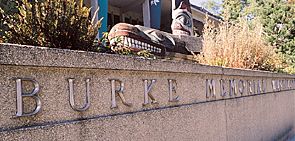
Sidebar: Guarding the Man
The Burke Museum of Natural and Cultural History has a skeleton in the closet. Well, not literally a closet, but the room where Kennewick Man rests his bones isn't much bigger.
Of course, you'll have to take Laura Phillips' word for it. Phillips, archaeology collection manager at the Burke, won't allow visitors to even see the door, much less peek inside.
The secrecy and security surrounding Kennewick Man's stay at the Burke is not without reason. Several of his precious bones turned up missing at his previous home, the Pacific Northwest National Laboratory in Richland, where he spent the first two years following his discovery.
The bones currently are the property of the federal government pending resolution of a lawsuit that will decide whether they should be repatriated to the Confederated Tribes of the Umatilla or released to scientists for further study.

The Ancient One's remains are housed at the Burke Museum. Photo by Jon Marmor.
Kennewick Man arrived at the Burke in October 1998 after the federal judge hearing the case ordered the government to find a more suitable repository for the remains. That has put the Burke in a delicate middle ground between two of its primary constituents—Native Americans and researchers.
"We're providing this service because we have the curatorial expertise," says Phillips. "We don't want to be perceived as taking one side or the other."
During his stay at the Burke, Kennewick Man has undergone several court ordered tests and studies. Besides periodic government inspections, those are the only times his bones are brought out.
The bones—more than 300 of them—are stored in cardboard boxes stacked in a metal cabinet. Each box contains all the bones for a particular part of the body—feet, hands, arms, legs—and each bone nestles snugly into a custom-shaped cushion at the bottom of its box.
When tests and studies are performed, campus police are alerted and the entire archaeology lab shuts down. Researchers wait in an examination room while a representative from the Burke and the government retrieve the bones. The two observers remain in the room to take notes of the proceedings, then count all the bones before returning them to storage. Representatives from the tribe and from the plaintiff scientists also attend.
Julie Stein, former curator of archaeology at the Burke, participated in one of the early court-ordered studies. The anthropologist examined sediments clinging to the bones to authenticate their age.
Although she considered it an honor, the circumstances were draining. "It was nerve-wracking to have people watching everything you do and questioning everything you do and knowing their observations could very well end up as testimony in a court case," she said.
Phillips says she fretted about potential confrontations between opposing parties in the case, but says everyone has remained calm. "Nobody wants it to get back to the court that they were behaving poorly," she says. While the tribe is eager for the Ancient One to return to the earth from which he was taken, he has been in good hands at the Burke, says Jeff Van Pelt, director of cultural resources programs for the Confederated Tribes.
That doesn't mean there haven't been any complaints. Van Pelt says that after some bone samples were taken for DNA testing, pipes in the museum's basement burst.
"That wasn't the Burke's fault," says Van Pelt. "That was the power of the Ancient One."
| On the Web: Burke Museum Kennewick Man Exhibit |
Go To: Page 1 | Page 2 | Page 3 | Page 4
- Sidebar: Guarding the Man
- Return to December 2000 Table of Contents